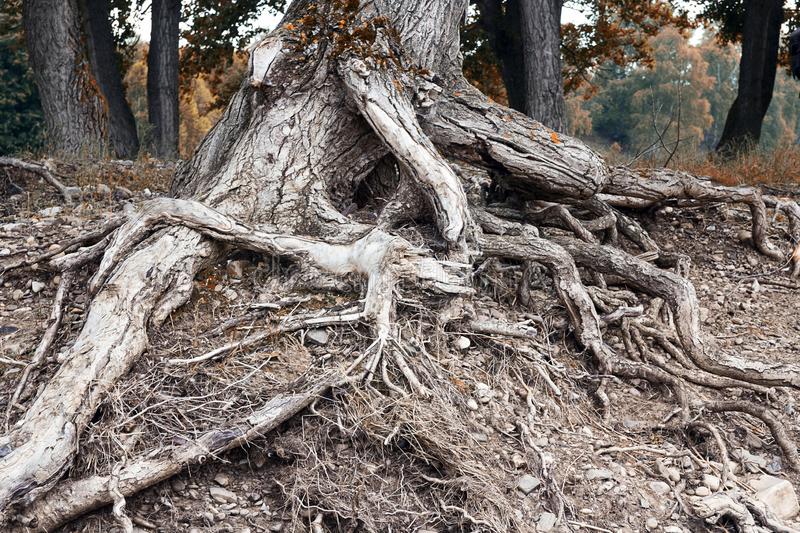Trees often develop roots above the surface of the ground. This is more common than you might think, but it’s not necessarily a reason for alarm. In most cases, surface tree roots are caused by poor planting techniques and poor soil conditions. It’s also normal for older trees to develop roots.
Table of Contents
How Tree Roots Grow
Tree roots are the foundation of a tree and all trees have them. Their job is to collect soil nutrients and stabilize the tree. While most tree roots are subterranean, they can sometimes grow above ground. This often occurs in areas with little topsoil. It is also a result of poor planting practices.
The type of root system a tree has determines its stability. Some species have a single type of root system while others have multiple systems. The type of root system depends on the species of tree, site conditions, and climate. Urban trees are generally characterized by lateral root systems, because they have shallow topsoil layers and frequent shallow irrigation. In contrast, some trees have extensive root systems, known as tap roots.
In addition to growing horizontally in the top few feet of soil, many trees also have roots that extend up to four times the diameter of the tree’s canopy. These surface roots help the tree survive in challenging conditions.

Why Tree Roots Grow Above the Ground
Tree roots are often found in the soil above the tree’s trunk, and the older the tree is, the more likely it will grow above ground roots. These are known as feeder roots, and they dig into the soil and push up other roots. While young trees don’t have above ground roots, mature trees do, and these roots can be dangerous.
Tree roots must be able to get nutrients and water from the soil around them. In fact, the roots will die if they can’t get enough water. Tree roots typically grow in the top four to twenty inches of soil, where moisture, oxygen, and nutrients are abundant. This is called the drip line, and the root system of a tree can spread far beyond this line.
While it is possible to prune tree roots that are less than two inches in diameter, it is best to keep them at least a foot away from the tree trunk. Exposed tree roots are hazardous to pedestrians, and you may want to remove them to prevent damage to your property or to prevent tripping hazards. You can also cover the root area with mulch to prevent any resulting damage to the surrounding landscape.
Why Exposed Tree Roots Are a Problem
Exposure of tree roots in lawns can pose a danger to people and business properties. Not only can they cause problems with mowers and other equipment, but they can also cause tripping hazards for kids. In addition, trees that have shallow roots can lead to erosion of soil surrounding them. In extreme cases, tree removal may be required.
Exposure of tree roots can be a serious problem if not treated promptly. Untreated exposed roots can make your tree susceptible to diseases and insects. In addition, the roots can be easily damaged by regular foot traffic. Wind and rain can also deplete the soil around the tree. If the exposed tree roots are not removed, they will eventually die. This will make the tree more susceptible to being blown over or catching fire in dry conditions.
Exposure of tree roots can be prevented by covering them with mulch. A layer of four inches will protect the roots and prevent them from drying out and sinking. This is the best solution for the problem. In addition, a layer of four inches of mulch will help the roots gather the needed nutrients.

How to Deal with Exposed Tree Roots
Tree roots that are exposed above ground can be dangerous for both your landscape and your property. Tree roots are especially hazardous for commercial businesses, as people walking through the landscape will more than likely trip over them. Luckily, there are several solutions that can help you keep your property safe. Here are some suggestions:
Exposure of tree roots can occur for many reasons, including soil erosion. In the case of windy locations, the soil can scout away from around exposed tree roots. Exposure can also happen from rain affecting bare soil, which causes it to compact and not absorb water.
If you find that your tree’s roots are exposed above ground, you should first determine whether you can safely prune them. If you can, keep them to one foot of the tree trunk. This will prevent them from damaging the surrounding property. However, if you are unsure of whether you can safely prune the roots, you should call a tree expert. Alternatively, you can cover the roots with a mulch bed.
What NOT to Do When Roots Grow Above Ground
Tree roots growing above ground are a common landscaping problem, but they are not as dangerous as you might think. Ideally, these roots will remain underground, about 12-20 inches below the surface of the soil. However, there are circumstances when exposed roots become a problem. If you notice this issue, there are a few things you can do to prevent further damage to your property.
First of all, make sure you remove any dead, diseased, or exposed tree roots from your property. Tree roots that are exposed can damage your lawn and cause tripping hazards. They can also be an entry point for insects and diseases. Also, they can ruin lawn equipment.
Another way to prevent roots from growing above ground is to cover the roots with soil or mulch. Using mulch is a good idea because it contains beneficial nutrients that can feed the tree. Cutting or pruning the exposed roots is not recommended, as it can damage the tree.

What You SHOULD Do With Exposed Roots
When tree roots emerge above ground, you’ve got a few options. One of the best and simplest is to add mulch, which will cushion the tree roots and discourage pedestrian traffic while eliminating the need for mowing. The best mulch is made of hardwood bark, which does not contain dyes and is environmentally friendly. However, you should be aware that mulch will not work in all situations. Listed below are some of the reasons you should avoid mulching bare tree roots.
Trees with exposed roots above the ground can be an eyesore, a tripping hazard, and a danger. While the tree may look beautiful and be an attractive landscape feature, it is not an ideal situation. Exposed tree roots can also harm your driveway, sidewalk, or foundation. Avoid disturbing the roots altogether unless you have to.
Exposure of tree roots can be a result of a variety of conditions, including drought, soil erosion, and cramped conditions. It is important to protect these roots and plant your trees in strategic locations. Avoid planting near hillsides and try to choose species with shallow root systems.
How to Prevent Roots From Growing Above Ground
The problem with exposed tree roots is that they are a tripping hazard and a source of damage. They also create an easy entryway for insects and diseases. These problems are most common with older trees that have little topsoil under them. Therefore, you must take steps to prevent tree roots from growing above ground.
One way to prevent exposed tree roots from growing is to cover them with soil or mulch. Mulch contains beneficial nutrients that replenish a tree’s nutrients. Another method is to cut back roots, but this may damage the tree. It is important to remember that pruning or cutting roots does not kill the tree.
A tree’s roots need water. If they are growing above ground, they will use most of the water in the soil. This can be very problematic, since they take up most of the water in the soil. However, if you’re planting plants that need little water, this may work.
Conclusion
Tree roots grow from the ground, not from the top. Many studies have been conducted to understand how the roots of different types grow. These studies provide valuable insights into how trees obtain water, minerals, and salt from their environment. Unfortunately, very few studies have focused on the development of the tree’s fine roots, which are primarily responsible for providing the tree with water and minerals.
These investigations are complicated by differences in environmental conditions. However, as the knowledge about root growth improves, practical conclusions can be drawn. For example, the optimum conditions for vigorous root growth are just as important for high productivity of a tree as are good conditions for its shoots. If you know the right environmental conditions, you’ll be able to create the ideal conditions for the growth of your trees’ roots.
While there are many variables influencing the development of tree roots, one of the most important variables is the depth of the soil. The deeper the soil gets, the greater the proportion of fine roots that develops. In addition, as the depth of the soil increases, the percentage of roots with a single diameter class increases.

